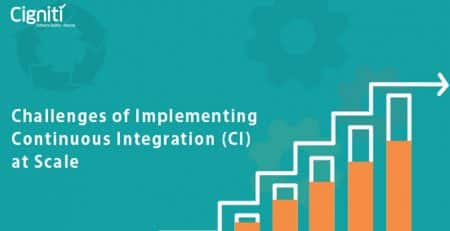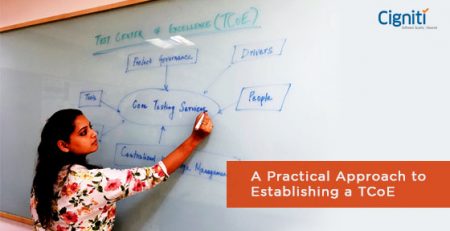5 Reasons Why It’s Time to Relook at Your Test CoE
There is an invisible, yet prominent line between pre-agile and post-agile tools, processes, and practices. Introduction of Agile methodologies in software development has led to the adoption of several new processes, while either scraping the old ones entirely or updating them to better adapt with the changes. Testing used to lurk behind the shadows of development phases in the pre-agile era. The idea of a centralized QA center was revolutionary in bringing testing out of that shadow and placing it at the heart of SDLCs.
A software testing center of excellence (TCoE) made for the nucleus of quality assurance activities for an application. After the developers are done developing the code, they hand it over to the dedicated TCoE for evaluation, where the code is subjected to different test environments using specific test data with the help of various tools. A testing center of excellence was essentially the hub where test data was stored, shared, and put into action for assessing the viability of a developed code.
Test CoEs operate on proprietary tools and platforms, which were sufficient until Agile dawned upon the IT industry. Post-agile, a role reversal happened for these platforms and tools. Instead of being the enablers, they became the obstacles to an efficiently run test. Being on the verge of redundancy, TCoEs must evolve to stay relevant and be the paragon of QA that it was before Agile happened.
Let us discuss five significant reasons that vanguard the need to reconceptualize TCoE.
To bridge the gap between development phase and testing phase
In the current scenario, where code has to be deployed at lightning fast speed, software development teams cannot afford to spend weeks, or even days on testing a code. Testing has to be quick, yet constructive at the same time. Taking a ‘test early, test often’ approach, organizations have rowed QA to the left in the development cycle. As the lines of responsibilities blur, developers are taking up the role of testers as well. Testing must be carried out simultaneously with developing.
In a traditional TCoE, the gap between testing and development is miles long. In order to cut short this gap and truly merge both the functions, it is necessary that organizations take a long and good look at their established TCoE framework and work out a way to make it relevant in the modern testing ecosystem.
To conceive a QA framework that combines the best of both worlds
As aforementioned, the pre-agile and post-agile worlds are vastly different from each other. The pre-agile TCoEs have to be modified, while keeping the key aspects that form the essence of such setup intact. There is a need to devise a QA framework that identifies and incorporates those strategies that are best-suited for the contemporary software development cycles.
The idea of a TCoE being a one-stop solution for testing should be amalgamated with avant-garde automated tools to realize the demand for early and effective quality assurance. Majority of the manual, iterative processes that consume a significant chunk of time should be delegated to automation tools. The traditional test CoEs are required to be transformed into a digital one, keeping the pace with the digitally transforming industry.
To not let the bugs slip away
Earlier, in the traditional SDLC setups, the urgency for quick deployments often caused testers to overlook and miss critical bugs, thus, releasing a defective application or software to the market. Performance glitches were identified at the time of actual use by the real users. Testers found themselves entangled in the vicious circle of short deadlines and tall quality requirements. In such cases, bugs and errors would go at large and turn up themselves later to ruin the user experience as well as organization’s credibility.
By incorporating a digital strategy in the TCoE framework using digitally-apt tools, processes, platforms, and people, it becomes possible to identify all the bugs, errors, and performance glitches at the time of testing itself. Armed with a detail-oriented eye, the digital TCoE can prove monumental in scanning the entire code within a very less timeframe and rectifying any detected error almost immediately.
To make sharing easy and accessible to all
SDLCs today employ open-source tools and platforms, which are not supported by the traditional software testing centers of excellence frameworks. In light of this, developers are unable to share a code change with the testers, rendering the entire TCoE framework unfit for meeting the current SDLC demands. In addition to hampering the efficacy of the testing center of excellence, this incompatibility severely handicaps the development cycle by obstructing the information and data sharing activities.
In order to channelize an unhindered flow of important information and to keep performing testing as fast as developing, migrating the existing QA TCoEs to open-source platforms may be considered.
To keep testers on their toes and prevent expensive delays
The conventional SDLCs involved a sequential process in which development came first, followed by testing and deployment. While the code was being developed, testers experienced a latent phase where they had nothing at hand to do. In addition to uneven work distribution, this strategy wasted valuable time of skilled manual professionals. In case of bug identification during the active testing period, the code was again sent to the developers for rework, thus, tampering with the established timeline and resulting in costly delays in the final release.
Agile has mandated co-location of all the involved teams in any SDLC. For the development life cycle to be ideally effective, co-functioning is as important as co-location. Continuous testing along with continuous delivery with optimal TCoE solutions can play an exceptional role in the success of an application.
The way ahead
A modern TCoE framework must operate on three essential factors – standardization, automation, and governance. Standardize and automate repetitive processes, while closely governing all the involved metrics to measure the strategic success of the revamped software testing center of excellence.
At Cigniti, we have in-house Software Testing Centers of Excellence Services dedicated towards Mobile, Performance, and Security Testing to deliver high value on our client’s QA investments.





Leave a Reply